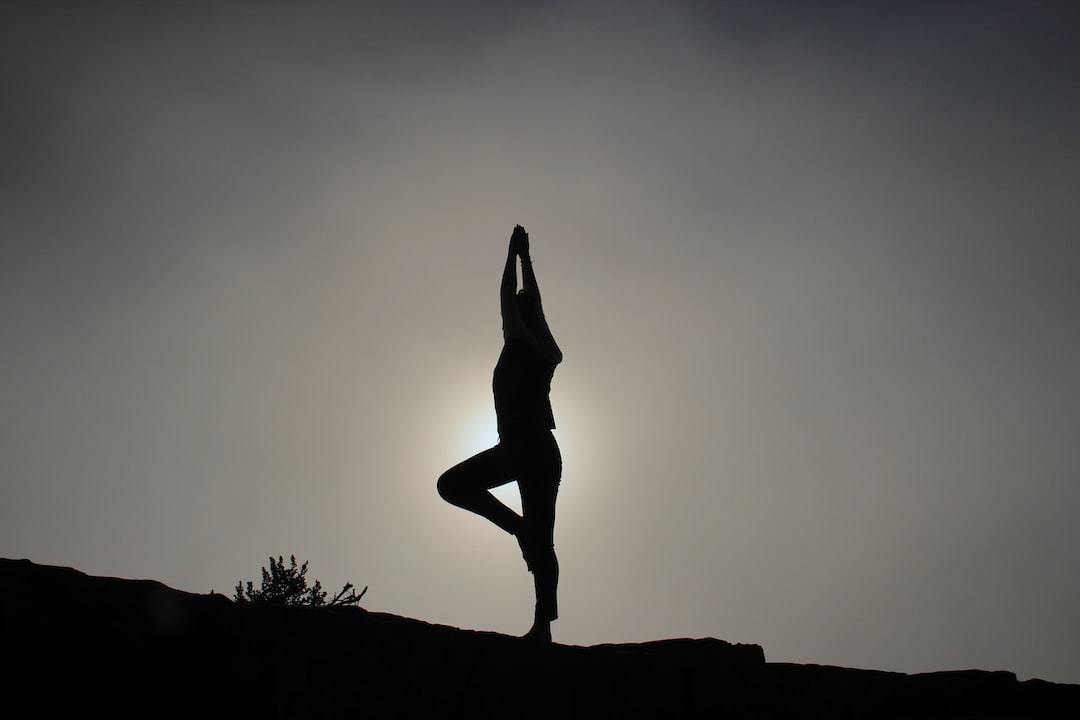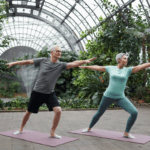Coming Soon: E-book about Kundalini Yoga - Sign up here to be among the first to get it!
Ever felt like you’re caught in a whirlwind, spinning without control? Or maybe you’ve experienced those days when your energy dips low and every task feels as though it’s uphill. It can be exhausting!
Welcome to the everyday balancing act of life.
Hatha yoga, an ancient practice with its roots deeply planted in Indian culture, promises a way out. Picture this: feeling grounded yet free-flowing like a mighty river that knows no obstruction; harnessing your internal sun and moon energies for balance; embodying grace under pressure – quite literally!
You may ask how one achieves such equilibrium?
The answer is simple – by combining physical postures, breath control, hand gestures and guided meditation all wrapped up in classical Hatha yoga practices.
I’m sure you’re eager to find out what’s next! Well, stay tuned!
Table Of Contents:
- What is Hatha Yoga?
- Core Teachings of Hatha Yoga
- Different Types and Schools of Hatha Yoga
- Health Benefits of Hatha Yoga
- Hatha Yoga Sequence and Poses
- How Hatha Yoga Differs from Other Types of Yoga
- Breathing Techniques and Exercises in Hatha Yoga
- Sun Salutation Practices in Hatha Yoga
- Ancient Texts and Influences on Hatha Yoga
- FAQs about Hatha Yoga
- Conclusion
What is Hatha Yoga?
Hatha yoga, a term that’s become synonymous with physical postures or asanas in the West, carries much more depth and tradition than it may initially seem.
This practice originated around 2000 years ago in India. It aims to balance the body and mind by harmonizing two primal energies – represented by ‘Ha’ (sun) and ‘Tha’ (moon).
The literal meaning of Hatha suggests effort or force. But don’t be mistaken. This doesn’t mean that you’ll need to strain yourself doing challenging poses. Instead, it implies an active engagement towards achieving a state of equilibrium between our physical bodies and subtle energy systems.
Roots In Ancient Traditions
In its original context, hatha yoga was considered a preliminary step for advanced meditation practices. By purifying the body, it created an ideal environment for harnessing higher energies, which is different from how yoga is commonly practiced today.
An Emphasis On Balance
Henceforth, at its core, hatha yoga focuses on cultivating balance — not just physically but also mentally and energetically.
A Holistic Practice For All
No matter your age or fitness level – from young adults to older practitioners – there’s something in store for everyone who steps onto the mat.
Moving Beyond The Physical
Beyond mere physical activity like other forms of exercise might offer; this classical form involves breath control techniques alongside hand gestures known as mudras which help guide internal energy flows better – making one’s experience truly holistic.
Promoting Greater Mindfulness
Practicing hatha yoga can be a stepping stone to greater mindfulness, where participants attributed increased awareness of their bodies and emotions.
A Path To Improved Health
Hatha Yoga helps not only improve balance but also provides numerous health benefits. Regular practice has been linked with relief from conditions like neck pain and anxiety while assisting people looking to quit smoking.
Delving deeper into Hatha Yoga reveals a 2000-year-old practice that goes beyond mere physical postures. It’s all about balancing the body and mind, blending effort with ease to harmonize our energies. No matter your age or fitness level, it welcomes everyone onto the mat for a truly holistic experience – promoting mindfulness, improved health, and more.
Core Teachings of Hatha Yoga
Hatha yoga, a treasure trove from India’s rich cultural heritage, is more than just a series of poses and breath control. Let’s dig into its core teachings.
The term ‘Hatha’ combines the energies of the sun (Ha) and moon (Tha), aiming to strike an optimal balance between body and mind. This delicate equilibrium forms the cornerstone of Hatha yoga practices.
The original practitioners, or yogis, were renunciates who took on extreme physical postures in their pursuit for spiritual liberation. Their legacy survives today as classical hatha yoga that emphasizes self-discipline.
Physical Postures & Breathing Techniques
Asanas, or physical postures are integral part of this practice – ranging from simple seated positions like lotus posture to physically challenging salutation practices.
An equally significant component is Pranayama – techniques focusing on breath control which play pivotal role in achieving mental clarity through concentration exercises called Dharana.
Mudras & Cleansing Techniques
Mudras, symbolic hand gestures employed during meditation facilitate energy flow within our bodies while enhancing focus levels.
Cleansing Practices
Beyond these tangible aspects lie Shatkarmas – cleansing procedures believed to purify both body and mind at deeper level thus helping with ailments such as neck pain amongst others.
This all-encompassing approach makes it easy to see why millions across globe vouch for effectiveness of hatha yoga class when it comes to improving overall well-being.
Remember folks. Practicing hatha can be much more than mere physical activity if you are willing to embrace its full spectrum.
Different Types and Schools of Hatha Yoga
Hatha yoga is a broad term that encompasses numerous styles. But each school has its unique emphasis, whether it’s on precise alignment or flowing movement.
Take Iyengar yoga for instance. It focuses heavily on posture precision and staying in poses for long periods to perfect them. On the other hand, Ashtanga Vinyasa flows smoothly from one pose to another with synchronized breathing.
Anusara yoga might be your cup of tea if you’re into heart-opening poses paired with positive philosophy while Sivananda prefers a more holistic approach, incorporating proper diet and meditation into the mix.
If power-packed sessions get your adrenaline pumping, then Power Yoga should top your list as it blends vigorous exercises within traditional postures.
Variety in Modern Day Hatha Classes
In today’s world where hybridity rules supreme, even hatha isn’t left untouched. You’ll find classes mixing different styles together like Yin-Yang Yoga which fuses passive yin stretches with dynamic yang flow sequences.
The Roots Run Deep
Acknowledging this rich variety doesn’t mean forgetting our roots though. Remembering ancient texts such as Hatha Yoga Pradipika, can help us appreciate how classical hatha branched out into these diverse schools over time. This revered text presents 84 physical postures among other practices making it an important foundation stone for all types of modern-day hatha practices.
Finding Your Flow
Your personal preference plays a huge role when choosing amongst these different types and schools. Whether you’re seeking a rigorous workout or tranquility of the mind, there’s a hatha style that can cater to your needs.So don’t be shy. Explore, experiment and discover what resonates with you most.
Health Benefits of Hatha Yoga
Hatha yoga, with its emphasis on physical postures and breath control, has been a beacon of wellness for centuries. But did you know it’s more than just a way to improve balance or get physically challenging?
This classical form of yoga can be your go-to guide for achieving greater mindfulness. Research supports the effectiveness of this practice in managing conditions like anxiety and depression [source].
A consistent hatha yoga class schedule might even help those looking to quit smoking. This surprising advantage was highlighted by the National Center for Complementary and Integrative Health [source], showing that this ancient practice could offer contemporary solutions. It’s not every day that an ancient practice offers modern solutions.
The Role Of Physical Postures
As part of hatha yoga practices, physical postures called asanas are designed to align skin, muscles, and bones.
These poses range from simple ones like Lotus posture which promotes flexibility in hips & knees; more complex inversions such as headstands – these encourage blood flow towards upper body & brain leading to better concentration.
Breath Control In Hatha Yoga
The salutation practices in Hatha Yoga use breath control techniques (Pranayama) helping us focus our minds while releasing tension from our bodies [source 1][source 2].
Mindfulness Through Guided Meditation
In addition to improving physical health through activity-focused exercises, participants attributed greater mindfulness when practicing guided meditation sessions often included in hatha yoga classes.
These meditative practices let you relax, de-stress and cultivate a peaceful state of mind.
Hatha Yoga for All Ages
Whether young adults seeking an active lifestyle or older adults looking to improve their mobility – hatha yoga is adaptable across age groups. The benefits are universal.
Hatha Yoga Sequence and Poses
Yoga enthusiasts will agree, there’s something magical about Hatha yoga sequences. They not only challenge the body but also soothe the mind.
The Hatha Yoga Pradipika, a classical text, lists 84 asanas or poses in its teachings.
Exploring Asanas in Hatha Yoga
In your hatha yoga class, you might have noticed that each session is like a well-orchestrated dance – flowing from one pose to another seamlessly.
Years of practice and comprehension of the body’s abilities and restrictions are necessary for a graceful transition from one asana to another in Hatha yoga.
Pose variations can range from simple seated postures like Lotus posture for beginners to more physically challenging ones such as inversions for seasoned practitioners. It makes sure everyone gets their dose of physical activity regardless of their level.
The secret behind this? A meticulous sequence. Let me explain how it works:
- Pose #1: A gentle warm-up pose kick-starts your session by prepping your muscles for what’s coming next.
- Pose #2: Next up are standing poses which work on improving balance while giving you an energy boost.
- Pose #3: Moving onto twists help cleanse internal organs through compression and release technique.
- Pose #4: You’ll then dive into forward bends designed to stretch hamstrings while calming down nervous system.
- Breath control exercises: Weaved throughout are pranayama practices teaching us breath regulation – after all, good breathing is at heart of any yoga practice.
Remember, it’s not just about mastering the poses. Hatha yoga focuses on holding each posture for several breaths to deepen the impact.
It helps you build strength and flexibility while improving range of motion – a win-win situation.
If you’re looking to start your journey or refine your hatha yoga practices, this beginner’s guide to hatha yoga might help.
If you’re just starting out with Hatha yoga, don’t worry about getting every pose perfect right away. Instead, focus on holding each one for several breaths. This will help strengthen your muscles and calm your nerves even more. Remember that this is a journey of both body and mind – take it at your own pace.
How Hatha Yoga Differs from Other Types of Yoga
If you’re a yoga enthusiast, you might have noticed how hatha yoga stands out.
This classical style is different in many ways.
Hatha isn’t about speed or flow like vinyasa yoga but focuses on slow and steady poses.
A Deep Dive into Poses Range
In hatha, the range of physical postures called asanas varies greatly.
From lotus posture to salutation practices, each pose helps improve balance and flexibility.
The Importance of Breath Control
Breathing techniques play an integral role too.
The emphasis on breath control aids mindfulness while making physically challenging poses more achievable.
The Power of Mindfulness & Meditation
Mindfulness isn’t just a buzzword here; it’s central to the practice.
Hatha integrates guided meditation which many participants attributed greater mindfulness after their sessions.
A Unique Approach for Everyone: Young Adults to Older Adults
Hatha classes are popular among young adults looking for physical activity and older adults seeking gentle exercises that help them stay flexible without straining themselves.
Breathing Techniques and Exercises in Hatha Yoga
Understanding breath control is a vital part of your hatha yoga practice. It’s not just about filling your lungs with air, but rather using conscious breathing to improve balance and focus.
In the realm of hatha yoga, we refer to this as pranayama – the formal practice of controlling the breath. This isn’t simply about gasping for oxygen during challenging poses or trying to catch our breath after an intense flow.
The Essence of Pranayama
Pranayama plays a significant role in hatha yoga practices. Its primary purpose? To help us harness our life force energy (prana) by guiding its flow through controlled breathing exercises.
This doesn’t mean you need superhuman lung capacity. In fact, pranayama encourages slow, mindful inhalations and exhalations which can be calming for both body and mind.
Nadi Shodhana: Alternate Nostril Breathing
An excellent starting point on your journey into pranayama would be Nadi Shodhana or alternate nostril breathing. As well as balancing left-right brain activity it promotes overall physical health by enhancing cardiovascular function.
Kapalabhati: Skull-Shining Breath
If you’re looking for something more physically challenging try Kapalabhati. Known also as ‘skull shining breath’, it’s a fantastic way to awaken the body and mind.
Practicing these techniques can make your hatha yoga experience richer and more fulfilling, as you get in tune with your breathing rhythm.
The Impact of Pranayama on Your Practice
By blending pranayama into your hatha yoga class, you can not only enhance balance but also foster deeper mindfulness with each pose. Each session then becomes a chance for personal growth on multiple levels – physical, mental, and spiritual.
Sun Salutation Practices in Hatha Yoga
Unfolding the magic of Surya Namaskar, or Sun Salutations, as it’s often known in hatha yoga classes is like opening a treasured chest. The journey starts with your feet firmly grounded and your hands reaching for the sky.
This ancient practice is not just about physical postures. It also encompasses breath control and guided meditation. In essence, it’s a tribute to the life-giving energy of the sun.
The process involves twelve different poses performed in sequence. Each movement corresponds to our solar cycle and aligns perfectly with our body’s rhythm.
If you want to learn more about the sequence Sun Salutation A and Sun Salutation B check this article here.
Meditative Aspects & Benefits
Sun salutations don’t stop at just being physically challenging though – they’re also incredibly meditative. By focusing on each pose, practitioners experience greater mindfulness. They feel more centered and calm.
The regular practice of Sun Salutations can also help improve balance and flexibility in young adults and older ones alike. Moreover, the breath control involved helps clear your mind making you more focused.
Role in Hatha Yoga
As they blend physical postures, sun salutation exercises stand as a fundamental element of hatha yoga.
Unravel the beauty of Sun Salutations in hatha yoga, a journey that starts from grounded feet to sky-reaching hands. It’s not just about poses but also breath control and meditation – all as an homage to the sun. Each pose represents our solar cycle, fostering mindfulness, balance, flexibility and focus.
Ancient Texts and Influences on Hatha Yoga
The story of hatha yoga began in the pages of ancient texts, setting the foundation for today’s practices.
One pivotal work is the ‘Hatha Yoga Pradipika‘, an Indian classic written by Swami Svatmarama. It’s a comprehensive guide to classical hatha yoga, discussing asanas (yoga postures), pranayama (breath control), mudras (hand gestures) and other vital aspects.
 get the book hereThis text represents an evolution from basic seated positions for meditation to a more complex range of poses. A remarkable 84 different asanas are detailed within its covers.
get the book hereThis text represents an evolution from basic seated positions for meditation to a more complex range of poses. A remarkable 84 different asanas are detailed within its covers.
These teachings have significantly influenced how we understand and practice yoga today. For example, lotus posture – one of the most recognized symbols worldwide – finds its roots here.
The richness of this ancient wisdom continues to inspire practitioners around the globe, fostering deeper connections between mind and body while enhancing physical activity through various postures.
If you would like to read more about Hatha check my post here about Best Books on Hatha Yoga and Best Books on Yoga.
Modern Adaptations: The Bridge Between Then And Now
In our modern world where everything evolves rapidly, it’s interesting how these age-old teachings continue to resonate with us deeply.
Whether it’s the invigorating sun salutations that kickstart your day or the calming guided meditations you do before bed, all these practices have roots in those early days. It was then when yogis began to translate what they read from ancient texts into their unique routines. As Michael Stone said so eloquently, “Yoga doesn’t just change how we view things; it fundamentally transforms who we become.”
FAQs about Hatha Yoga
How is hatha yoga different?
Hatha yoga places equal emphasis on physical postures and meditation, aiming to balance the body’s energies for a harmonious existence.
What is the Hatha style of yoga?
The Hatha style blends physical poses with deep breathing exercises. It focuses on calming the mind while improving strength and flexibility.
Is hatha yoga hard for beginners?
No, it isn’t. Hatha Yoga has beginner-friendly poses making it an excellent starting point for those new to practicing yoga.
What is unique about hatha yoga?
Hatha Yoga uniquely combines asanas (poses), pranayama (breathing techniques), mudras (gestures) and mantras (chants) in its practice for overall wellness.
Conclusion
So, you’ve journeyed through the ancient world of hatha yoga. It’s been an enlightening ride!
You’ve discovered its Indian origins and how it balances body and mind by marrying sun (Ha) and moon (Tha) energies.
We delved into core teachings from physical postures to breath control, hand gestures, even guided meditation. You explored various styles within Hatha yoga – each unique in approach but united in purpose.
Hatha Yoga offers health benefits aplenty! Anxiety? Check. Back pain? Check. Quit smoking? Even that’s possible with regular practice!
You learned about asanas or poses enhancing your well-being; breathed life into pranayama techniques; practiced Sun Salutations while soaking up their significance;
Remember those key takeaways: balance is achievable through discipline, focus on posture coupled with breathing brings vitality and a deep understanding of ancient texts can guide modern practices.
sign up to our newsletter to stay updated with our latest articles





